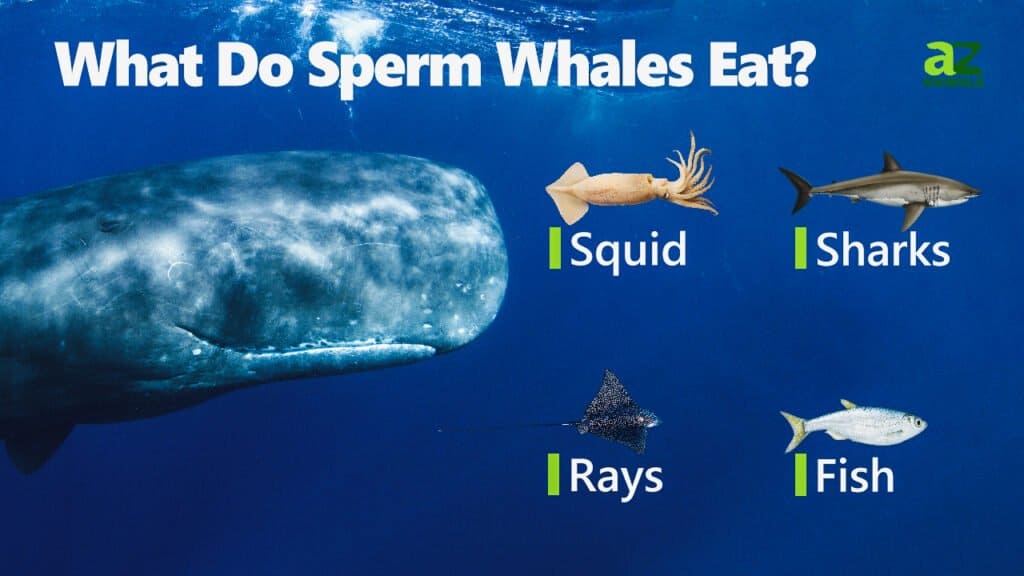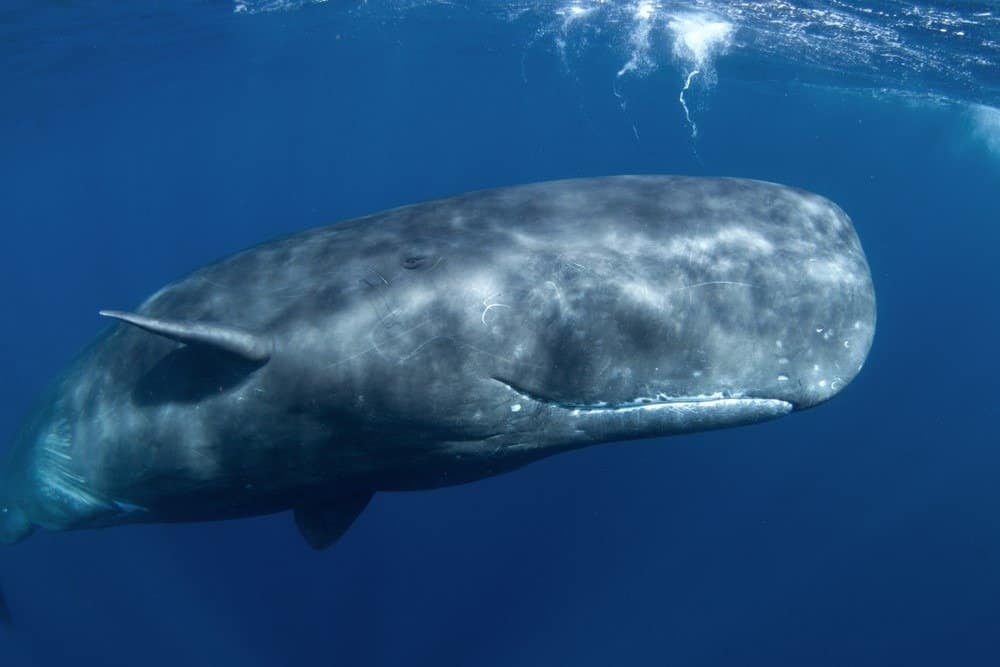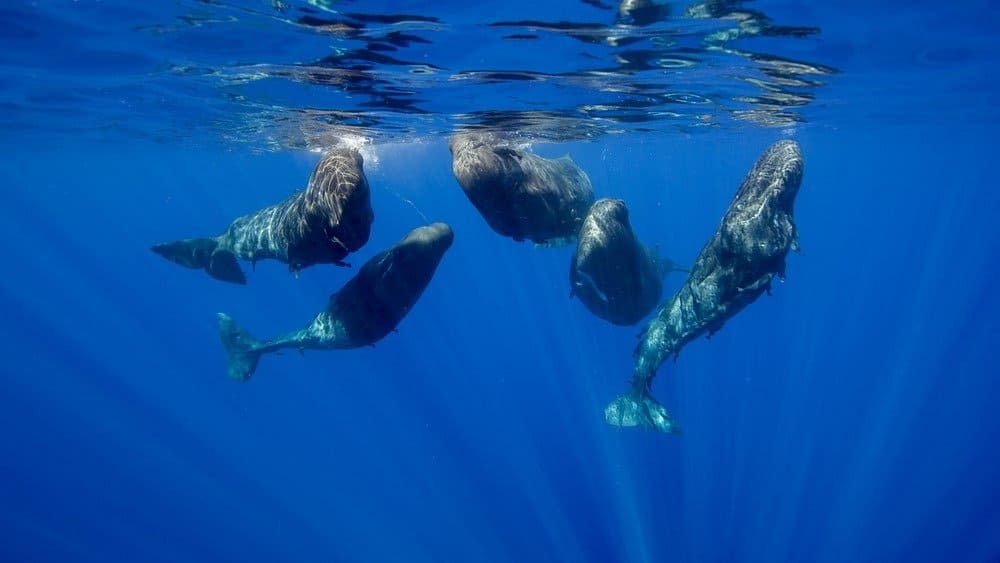The sperm whale is the world’s largest toothed whale and can be found in oceans all over the world, from the Arctic to Antarctica.
Their interesting name is credited to early whalers who discovered the spermaceti, a waxy substance that these whales produced from their heads. Initially assuming it was “whale seed,” researchers today have found that this gooey substance may actually help to regulate the whale’s buoyancy.
Sperm whale populations have been found to be dispersed between the north and southern hemisphere. It is common for males to habit the polar region while females spend more of their time with young whales in more pleasant waters.
As the world’s largest toothed whale, it’s hard not to wonder what they eat and how they hunt down their food. We’ll explore what sperm whales eat, how they hunt for food in the ocean and many other questions that will help you better understand these aquatic giants.
What Do Sperm Whales Eat?

Sperm whales eat a diet that consists of squid, sharks, shrimp, and other fish. They are predominately carnivores and are considered an apex predator of the ocean. Since they are so large, it is not uncommon for sperm whales to accidentally take in other items or aquatic creatures when devouring their prey.
Take a look at some of the foods that sperm whales eat:
- Giant and colossal squid
- Octopus
- Cephalopods
- Cuttlefish
- Fishes (rockfishes, cod, sharks, rag fish, skate, dory-type fish, ling, and lumpsucker)
- Crabs
- Shrimp
- Krill
- Lobsters
Out of all of these food options, squid is by far the most important for their species as it makes up a majority of their diet. Researchers have also found colonial tunicates, jelly-fishes, sponges, starfish, sea cucumbers, and gorgonians in sperm whale stomachs.
How Much Do Sperm Whales Eat?

Sperm whales are always eating.
©Martin Prochazkacz/Shutterstock.com
Sperm whales are constantly eating and they can eat about three percent of their body weight daily. This usually amounts to a little over 900 kg (almost 2,000 pounds) of food per day.
Squid happens to be their favorite food option as females can eat anywhere between 700-800 squids in a day while males put away 300-400 squids in a day. Squids are such an important staple in their diet. It has been esteemed that sperm whales eat roughly 110-320 million tons of squid in a year.
Who Competes With Sperm Whales For Food?
Killer whales (also called orcas) are another toothed whale that is considered an apex predator. Like sperm whales, they also feed on fish and squid. This means that sperm whales and orcas are in competition for food sources. It has even been noted that male adult sperm whales will occasionally attack orcas to compete for food.
Do Sperm Whales Have any Predators?
Orcas are the largest natural threat to sperm whales. Since orcas and sperm whales eat a similar diet they are in competition with one another for food. Orcas have also been known to attack sperm whale pods and make attempts to hunt their calves and females. However, they tend to avoid the males as they are often too large to hunt easily.
Along with orcas, sperm whales are sometimes attacked by pilot whales and false killer whales. Outside of other aquatic predators, sperm whales have also been preyed upon by humans.
According to the National Oceanic and Atmospheric Administration, humans hunted sperm whales all throughout the 1800s and 1900s for their spermaceti oil, which was used in oil lamps and other items. Today, whale hunting is banned in most countries, however, sperm whales can also be harmed when they get caught in fishing nets and gear.
How Do Sperm Whale Hunt?

Sperm whales use echolocation to locate their prey.
©wildestanimal/Shutterstock.com
The sperm whale can swim at a speed of 23 miles per hour and can spend 90 minutes under the water before having to return to the surface to breathe. When hunting for food, sperm whales are able to dive more than 3000 feet deep.
Sperm whales use their noses to use echolocation, which sends out a series of clicks, that allows them to focus in on their prey. Sperm whales have small eyes and poor eyesight.
The echolocation allows them to hunt deep in the waters where there is no light for them to see. As they send out the sound, the whales will wait for an echo in order to determine how far away their next meal is. Sperm whales are the loudest animals on Earth and can produce noise at 233 decibels.
Are Sperm Whales Dangerous To Humans?

Sperm whales do not usually attack humans unprovoked.
©wildestanimal/Shutterstock.com
As such a large animal with big teeth, it can be easy to assume that sperm whales are a threat to humans. However, despite their intimidating size, sperm whales have generally been recorded as being quite friendly to humans. While attacks on humans do happen, it is usually only a cause for concern when they feel attacked or provoked.
They also rarely eat mammals and only do so when they have mistaken them for another food.
Sperm whales will also normally avoid ships when they hear them. However, they have been known to drive themselves into small boats on rare occasions. Some experts believe that sperm whales remember previous human aggressiveness and have grown antagonistic towards us. Others believe that these crashes are merely coincidental.
How Does Their Diet Impact Other Species
Whales contribute to the environment and the ocean’s ecosystem in big ways. They are responsible for maintaining a stable food chain and ensuring that specific animal species do not overpopulate the water.
Studies have also found that sperm whale excrement helps to fertilize the seas. The feces float upward where phytoplankton eat them.
Phytoplankton is incredibly important as they remove carbon from the atmosphere, essentially providing us with clean air to breathe. Phytoplankton is also a huge food source for many species of fish, which keeps the food chain in the oceans stable.
The photo featured at the top of this post is © bekirevren/Shutterstock.com
Thank you for reading! Have some feedback for us? Contact the AZ Animals editorial team.






